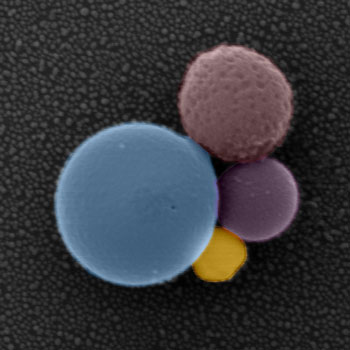| Mar 14, 2019 | |
Bottom-up assembled chiral meta-molecules |
|
| (Nanowerk Spotlight) The application of chiral nanoparticles in chemistry, biology and medicine is of great importance for the development of new molecular nanosystems. In chemistry, chirality usually refers to molecules and is a ubiquitous phenomenon in the natural world. | |
| A chiral molecule is a type of molecule that lacks an internal plane of symmetry and has a non-superimposable mirror image; examples of this are amino acids and sugars. Two mirror images of a chiral molecule are called enantiomers or optical isomers. Pairs of enantiomers are often designated as right-handed and left-handed. | |
| Inspired by chiral molecular structures, scientists are developing strategies to build artificial chiral materials by mimicking natural molecular structures using functional materials. Specifically, metal nanomaterials exhibit tailorable optical properties upon excitation of surface plasmons and become one of the most promising components to realize chiral optical metamaterials. | |
| Understanding the optical chirality of organic molecules at the atomic scale is extremely challenging due to the difficulty to observe and control the atomic configuration at sub-nanometer level. New work reported in Materials Today ("All-optical reconfigurable chiral meta-molecules") provides a macroscopic model to understand the origin of chirality because the structures of the chiral meta-molecules are observable under a microscope and also the optical chirality is several orders of magnitude stronger than the intrinsic chirality of organic molecules. | |
| In this research, scientists from The University of Texas at Austin and The City University of New York, mimic the organic chiral molecules found in nature by using opto-thermoelectric nanotweezers to assemble different metallic and dielectric meta-atoms into chiral meta-molecules using a laser. | |
 |
|
| A color SEM image of an assembled chiral meta-molecule. (Source: Zheng Group, The University of Texas at Austin) | |
| These meta-molecules provide a macroscopic model to understand the origin of chirality at the atomic scale, while the approach provides a versatile platform to fabricate active chiral devices in nanophotonics and optofluidics. | |
| There are also other existing techniques to assemble colloids into chiral meta-molecules. For example, DNA origami technology provides a programmable template for a precise organization of colloids into a variety of two-dimensional (2D) or three-dimensional (3D) chiral architectures. However, the tunability is still limited to a few pre-established discrete states and on-demand reconfigurability is still elusive. | |
| This motivated the team to develop an on-demand assembly technology, which can deal with colloidal particles in a wide range of materials and sizes with versatile control of the molecular geometry and reconfigurability. | |
| "We use a laser beam to build chiral meta-molecules 'atom-by-atom' mimicking the organic chiral molecules in nature, with their optical chirality analyzed in situ," Dr. Linhan Lin, first author of the paper, tells Nanowerk. "Specifically, the molecular structure is tunable and reconfigurable through steering the laser beam to obtain their enantiomers and diastereomers." | |
| Using colloids (meta-atoms) to mimic the atoms for bottom-up assembly of chiral molecules is conceptually simple, while technically challenging, Lin explains. The technical bottleneck arises from the difficulty to pick up diverse meta-atoms and organize them into specific geometry, which is beyond the capability of a traditional self-assembly approach. | |
| To address this challenge, the team led by professors Andrea Alù, Brian A. Korgel and Yuebing Zheng, proposes to use light as a tool to control the meta-atoms and to bond these meta-atoms into molecular structures. | |
| This novel approach to build and detect chiral meta-molecules with light could benefit applications in chiral sensing of drug molecules (the capability to switch the chiral meta-molecules between their enantiomers enables their application to identify and differentiate drug molecules) and the fabrication of chiral photonic devices (the capability to selectively pick colloids with different sizes and materials enables the fabrication of active nanophotonic devices). | |
| This video demonstrates the step-by-step assembly process of a meta-molecule with laser light. | |
| In the next stages of their research, the team will investigate the interaction between the chiral meta-molecules and organic chiral molecules in microfluidic devices for chiral sensing, i.e., identify the handedness of the chiral molecules. They will also add fluorescence colloids into the chiral meta-molecules to investigate the interaction between the emitted photon and the chiral meta-molecules to achieve colloidal chiral light sources. | |
| "With the development of fabrication and assembly technology in nanomaterials, we expect that the assembly of chiral meta-molecules will become more rational and intelligent," Zheng concludes. "We anticipate that in the near future, the assembly of chiral materials based on the required optical performance will become possible. Beyond the assembly technology itself, the capability to identify the meta-atoms smartly and to design the geometry of chiral meta-molecules based on the performance requirement will be the major challenges." | |
 By
Michael
Berger
– Michael is author of three books by the Royal Society of Chemistry:
Nano-Society: Pushing the Boundaries of Technology,
Nanotechnology: The Future is Tiny, and
Nanoengineering: The Skills and Tools Making Technology Invisible
Copyright ©
Nanowerk LLC
By
Michael
Berger
– Michael is author of three books by the Royal Society of Chemistry:
Nano-Society: Pushing the Boundaries of Technology,
Nanotechnology: The Future is Tiny, and
Nanoengineering: The Skills and Tools Making Technology Invisible
Copyright ©
Nanowerk LLC
|
|
|
Become a Spotlight guest author! Join our large and growing group of guest contributors. Have you just published a scientific paper or have other exciting developments to share with the nanotechnology community? Here is how to publish on nanowerk.com. |
|
